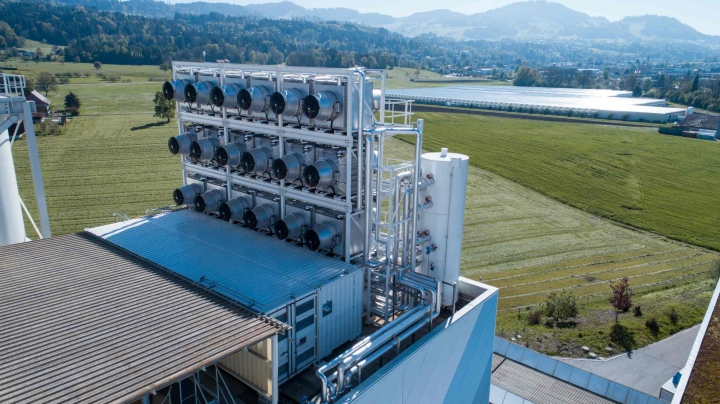
The backdrop: cuts, exits, and confusion
It’s been a strange few weeks in the clean tech world.
On one side, the U.S. Department of Energy is weighing cuts to high-profile carbon capture and energy storage projects. That includes $890 million meant for large-scale CCS efforts across California, Texas, and North Dakota, plus $350 million in advanced battery tech grants. Long-duration storage projects by NextEra, Westinghouse, and startups like Smartville and ReJoule are on shaky ground. Same goes for Urban Electric Power, which had been pushing innovative zinc manganese batteries.

U.S. Secretary of Energy Chris Wright speaks to the media, outside of the West Wing of the White House, in Washington, D.C., U.S., March 19, 2025.
"We are actively working to communicate the importance of our work to Energy Secretary Chris Wright," said Zora Chung, co-founder of ReJoule. "We believe this is an issue of national interest that transcends party lines."
At the same time, oil majors like BP and Shell are pulling the plug on their hydrogen transport ambitions. BP quietly dissolved its low-carbon mobility team. Shell shut down all of its hydrogen stations in California. Chevron is sticking around—but mainly to leverage state subsidies. TotalEnergies and Equinor are also shifting their focus away from hydrogen transport, betting instead on heavy industry and shipping.
It’s tempting to read all this as bad news. But maybe it’s not the collapse of clean tech. Maybe it’s a reset.
>> RELATED: Hydrogen Hope on the Chopping Block: How ARCHES and Other Blue-State Projects Got Caught in the Crossfire

What’s really going on?
Startups and multinationals aren’t dropping hydrogen or carbon capture because the tech doesn’t work. They're adjusting because the investment climate—and government support—just shifted. And despite headlines, a deeper look shows the long-term fundamentals remain sound, especially for hydrogen and CCS in industrial settings.
Hydrogen still has a place. So does carbon capture. Especially in North America, where resources and infrastructure can support next-gen energy.
1. Direct air capture and CCS are still foundational
Yes, the DOE is considering cutting two Direct Air Capture hubs in Texas and Louisiana. That’s concerning. But this doesn't mean the U.S. is abandoning carbon removal.
Groups like the Carbon Capture Coalition are pushing hard to reverse course. Projects have already started drilling test wells and building infrastructure. Jessie Stolark, the Coalition’s executive director, warned, "To pull back at this moment in time is catastrophic."
Why does it matter? Because CCS is essential for decarbonizing sectors like cement, steel, and chemicals—industries that can’t simply electrify.
Companies like ExxonMobil and Equinor know this. Exxon’s Baytown project in Texas is set to become the world’s largest blue hydrogen facility—fossil-derived hydrogen paired with carbon capture. No, it’s not green hydrogen yet, but it’s an important bridge.
2. Blue hydrogen: not a compromise, but a catalyst
Blue hydrogen is gaining ground, especially in the U.S., which has abundant natural gas and a head start on pipeline networks. With the right CCS tech layered in, blue hydrogen becomes a scalable way to meet short-term demand while building toward a greener system.
Even if BP and Shell are stepping back from hydrogen cars, the industry isn’t vanishing. It’s maturing. It's shifting from hype to reality, focusing on use cases that actually make sense.
Think shipping, aviation, industrial heat. Not consumer sedans.

>> In Other News: BBVA and Técnicas Reunidas Team Up to Promote Industrial Decarbonization
3. Tariffs could kickstart North American hydrogen production
President Trump’s proposed tariffs might cause short-term pain, but they could also accelerate domestic hydrogen production. More tariffs mean more pressure to localize electrolyzer, storage, and fuel cell manufacturing. This could create jobs and boost innovation within the U.S.
Sure, there are risks—rising costs, possible supply chain friction. But it could also spur the buildout of a more self-sufficient hydrogen ecosystem. Pipelines, fueling stations, storage hubs—this is where domestic investment matters most.
4. Bioenergy and sustainable aviation fuels still moving forward
While some sectors face hurdles, others are quietly gaining steam. Sustainable aviation fuels (SAFs), for instance, are starting to attract the kind of long-term contracts and public-private partnerships that can drive scale. Same goes for carbon-negative bioenergy, especially in agricultural regions with access to waste biomass.
ExxonMobil’s partnership with Porsche to explore synthetic fuels for aviation is one to watch. It blends blue hydrogen and carbon capture into a promising low-carbon liquid fuel strategy.
5. Regional hydrogen hubs are the future
Forget global hydrogen shipping routes—for now. What’s emerging is more practical: regional hydrogen ecosystems.
Think of it as clean energy localism. The U.S. and Canada can pair up: Canada supplies renewables, the U.S. builds tech, and Mexico contributes labor and materials. The EU is doing the same within its borders. Even China is going all-in domestically.
This isn’t failure. It’s adaptation. Strong regional markets might actually work better than fragile global pipelines.
The bottom line
The story isn’t that hydrogen and carbon capture are falling apart. The story is that they’re growing up. There’s no quick win, no one-size-fits-all solution. But there’s still a future.
Not every hydrogen station will survive. Not every battery startup will land funding. And not every major will keep pretending hydrogen cars are coming. But industrial hydrogen, CCS for heavy manufacturing, and low-carbon fuels for planes and ships? Those are staying.
And they’re needed.
We shouldn’t confuse near-term recalibration with long-term failure. The companies that stay focused—like ExxonMobil, TotalEnergies, Equinor, and the smaller tech developers still hanging on—are quietly shaping the real future of clean energy.
The road might twist. But it's still headed in the right direction.
Subscribe to the newsletter
Daily decarbonization data and news delivered to your inbox
Follow the money flow of climate, technology, and energy investments to uncover new opportunities and jobs.
Companies
Latest issues
-
Inside XCF Global's $300M Bet to Double U.S. SAF Output
Inside This Issue ✈️ Inside XCF Global's $300M Bet to Double U.S. SAF Output ⚙️ Capsol Technologies Signs MoU with US Utility to Deploy CapsolGT® for Low-carbon Gas Power Generation 🏭 Babcock &...
-
64 Carbon Projects Were Stuck. Texas Just Unlocked Them
Inside This Issue 🛢️ 64 Carbon Projects Were Stuck. Texas Just Unlocked Them ⚙️ In Ohio, Hydrogen Industry Presses on Despite Federal Uncertainty 🧲 Agami Zero Breaks Through With Magnetic Hydrogen...
-
This U.S. Plant Might Change Aviation Forever
In This Issue 🛫 A Georgia Plant Just Cracked Aviation's Fuel Puzzle 📉 CO2RE And ERM Release 2025 Update On Greenhouse Gas Removal Costs 🔗 Abatable Partners With BlueLayer To Streamline Corporate C...
Company Announcements
-
Peregrine Hydrogen and Tasmania Energy Metals Sign LOI for Nickel Processing Plant in Bell Bay
MOUNTAIN VIEW, Calif. & BEACONSFIELD, Tasmania – Peregrine Hydrogen and Tasmania Energy Metals ("Tasmetals") today announced they have signed a Letter of Intent (LOI) to co-locate Peregrine’s p...
-
Anaergia Technologies, LLC to Provide Integrated Waste-to-Energy Technology for PepsiCo Mexico Foods
Contract Extending Relationship with PepsiCo is Anaergia’s First Project in Mexico CARLSBAD, California & BURLINGTON, Ontario—Anaergia Inc. (TSX: ANRG) (OTCQX: ANRGF), through its subsidiary, ...
-
Green Plains Achieves a Milestone as CO2 from Nebraska is Sequestered in Wyoming
All Three Nebraska Facilities Now Capturing CO2; First 45Z Payment Demonstrates Early Value OMAHA, Neb.—Green Plains Inc. (NASDAQ: GPRE) today announced that biogenic carbon dioxide from all three...
-
North America on Track for ICAO’s 2030 Cleaner-Energy Target as Other Regions Lag
IBA, the aviation market intelligence and advisory company, reports that North America is currently the only global region on track to meet the International Civil Aviation Organisation (ICAO) clea...
